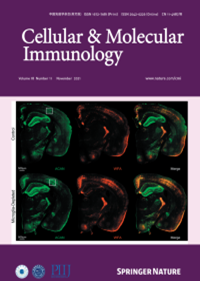Peroxisome proliferator-activated receptor alpha is an essential factor in enhanced macrophage immune function induced by angiotensin-converting enzyme
IF 19.8
1区 医学
Q1 IMMUNOLOGY
引用次数: 0
Abstract
Increased expression of angiotensin-converting enzyme (ACE) by myeloid lineage cells strongly increases the immune activity of these cells, as observed in ACE10/10 mice, which exhibit a marked increase in antitumor and antibactericidal immunity. We report that peroxisome proliferator-activated receptor alpha (PPARα), a transcription factor that regulates genes critical for lipid metabolism, is a key molecule in the enhanced macrophage function induced by ACE. Here, we used a Cre–LoxP approach with LysM-Cre to create a modified ACE10/10 mouse line in which macrophages continue to generate abundant ACE but in which monocyte and macrophage PPARα expression is selectively suppressed. These mice, termed A10-PPARα-Cre, have significantly increased growth of B16-F10 tumors compared with ACE10/10 mice with Cre expression. PPARα depletion impaired cytokine production and antigen-presenting activity in ACE-expressing macrophages, resulting in reduced tumor antigen-specific CD8+ T-cell generation. Additionally, the elevated bactericidal resistance typical of ACE10/10 mice was significantly reduced in A10-PPARα-Cre mice, such that these mice resembled WT mice in their resistance to methicillin-resistant Staphylococcus aureus (MRSA) infection. THP-1 cells expressing increased ACE (termed THP-1-ACE) constitute a human macrophage model with increased PPARα that shows enhanced cytotoxicity against tumor cells and better phagocytosis and killing of MRSA. RNA silencing of PPARα in THP-1-ACE cells reduced both tumor cell death and bacterial phagocytosis and clearance. In contrast, the in vivo administration of pemafibrate, a specific agonist of PPARα, to WT and A10-PPARα-Cre mice reduced B16-F10 tumor growth by 24.5% and 25.8%, respectively, but pemafibrate reduced tumors by 57.8% in ACE10/10 mice. With pemafibrate, the number of antitumor CD8+ T cells was significantly lower in A10-PPARα-Cre mice than in ACE10/10 mice. We conclude that PPARα is important in the immune system of myeloid cells, including wild-type cells, and that its increased expression by ACE-expressing macrophages in ACE10/10 mice is indispensable for ACE-dependent functional upregulation of macrophages in both mice and human cells.

过氧化物酶体增殖物激活受体α是血管紧张素转换酶诱导巨噬细胞免疫功能增强的重要因素。
在ACE10/10小鼠中观察到,髓系细胞血管紧张素转换酶(ACE)表达的增加强烈地增加了这些细胞的免疫活性,其抗肿瘤和抗菌免疫能力显着增加。我们报道过氧化物酶体增殖激活受体α (PPARα)是一种调节脂质代谢关键基因的转录因子,是ACE诱导巨噬细胞功能增强的关键分子。在这里,我们使用Cre-LoxP方法和LysM-Cre创建了一个改良的ACE10/10小鼠系,其中巨噬细胞继续产生丰富的ACE,但单核细胞和巨噬细胞PPARα的表达被选择性抑制。这些小鼠被称为A10-PPARα-Cre,与Cre表达的ACE10/10小鼠相比,B16-F10肿瘤的生长明显增加。PPARα缺失会破坏表达ace的巨噬细胞的细胞因子产生和抗原呈递活性,导致肿瘤抗原特异性CD8+ t细胞生成减少。此外,在A10-PPARα-Cre小鼠中,ACE10/10小鼠典型的抗菌抗性升高明显降低,使得这些小鼠对耐甲氧西林金黄色葡萄球菌(MRSA)感染的抗性与WT小鼠相似。表达ACE增加的THP-1细胞(称为THP-1-ACE)构成了PPARα增加的人巨噬细胞模型,显示出对肿瘤细胞增强的细胞毒性和更好的吞噬和杀死MRSA。RNA沉默THP-1-ACE细胞中的PPARα可减少肿瘤细胞死亡和细菌吞噬和清除。相比之下,ppara α特异性激动剂pemafibrate在WT和a10 - ppara α- cre小鼠体内分别使B16-F10肿瘤生长减少24.5%和25.8%,而在ACE10/10小鼠中,pemafibrate使肿瘤生长减少57.8%。pembro颤动治疗后,A10-PPARα-Cre小鼠抗肿瘤CD8+ T细胞数量明显低于ACE10/10小鼠。我们得出结论,PPARα在骨髓细胞(包括野生型细胞)的免疫系统中是重要的,并且在ACE10/10小鼠中表达ace的巨噬细胞中其表达的增加对于小鼠和人类细胞中巨噬细胞的ace依赖性功能上调是必不可少的。
本文章由计算机程序翻译,如有差异,请以英文原文为准。
求助全文
约1分钟内获得全文
求助全文
来源期刊
CiteScore
31.20
自引率
1.20%
发文量
903
审稿时长
1 months
期刊介绍:
Cellular & Molecular Immunology, a monthly journal from the Chinese Society of Immunology and the University of Science and Technology of China, serves as a comprehensive platform covering both basic immunology research and clinical applications. The journal publishes a variety of article types, including Articles, Review Articles, Mini Reviews, and Short Communications, focusing on diverse aspects of cellular and molecular immunology.

 求助内容:
求助内容: 应助结果提醒方式:
应助结果提醒方式:


